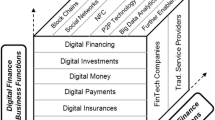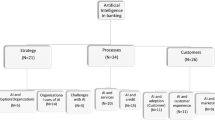Abstract
Significant changes have affected the banking sector worldwide due to the major impact of developments and trends in information and communication technology, business intelligence, and risk management strategies. The basic issue to be addressed no longer concerns changes in the banking sector but the ways to better operate in the new business setting in order to redefine relationships with customers, seize the opportunities provided by the innovation processes, and yield adequate returns. A bank willing to progress has to continuously adapt to the evolving economic, financial, and productive context. This work argues about the influence of the advancement and complexity of emerging technologies on the structural and behavioral elements meant as financial criticalities and requirements restricting the strategic development options of banks. Verification of the research hypotheses was made through an empirical analysis of quantitative and qualitative data regarding the period 2008–2011 gathered from a sample of 3190 banks located in 17 countries. The empirical research shows (1) the existence of a negative relationship between financial leverage and the two technological innovations regarding enterprise resource planning software systems and software for management of credit risk were observed; (2) the enterprise resource planning innovation and the software for the management of credit risk seem to influence competences, abilities, and organization of the banking system; (3) the innovations that concern the enterprise resource planning software systems and the software for the management of credit risk increase the earning margin of banks.
Similar content being viewed by others
References
Anderson, M. C., Banker, R. D., & Ravindran, S. (2006). Value implications of investments in information technology. Management Science, 52(9), 1359–1376.
Bantel, K. A., & Jackson, S. E. (1989). Top management and innovations in banking: does the composition of the top team make a difference? Strategic Management Journal, 10(S1), 107–124.
Bartoloni, E. (2013). Capital structure and innovation: causality and determinants. Empirica, 40(1), 111–151.
Bourke, P. (1989). Concentration and other determinants of bank profitability in Europe, North America and Australia. Journal of Banking & Finance, 13(1), 65–79.
Cabrita, M. D. R., & Bontis, N. (2008). Intellectual capital and business performance in the Portuguese banking industry. International Journal of Technology Management, 43(1), 212–237.
Campanella, F., Del Giudice, M., & Della Peruta, M. R. (2013). The role of information in the credit relationship. Journal of Innovation and Entrepreneurship, 2(1), 1–16.
Cowling, A., & Newman, K. (1995). Banking on people: TQM, service quality and human resources. Personnel Review, 24(7), 25–40.
Davenport, T. H. (2013). Process innovation: reengineering work through information technology. Harvard Business Press
Degryse, H., & Ongena, S. (2004). The impact of technology and regulation on the geographical scope of banking. Oxford Review of Economic Policy, 20(4), 571–590.
Del Giudice, M., & Straub, D. (2011). IT and entrepreneurism: an on-again, off-again love affair or a marriage? MIS Quarterly, 35(4), 3–8.
Del Giudice, M., Della Peruta, M. R., & Maggioni, V. (2013). Collective knowledge and organizational routines within academic communities of practice: an empirical research on science-entrepreneurs. Journal of the Knowledge Economy, 4(3), 260–27.
Durkin, M. G., & Howcroft, B. (2003). Relationship marketing in the banking sector: the impact of new technologies. Marketing Intelligence & Planning, 21(1), 61–71.
Jayawardhena, C., & Foley, P. (2000). Changes in the banking sector—the case of Internet banking in the UK. Internet Research, 10(1), 19–31.
Joseph, M., & Stone, G. (2003). An empirical evaluation of US bank customer perceptions of the impact of technology on service delivery in the banking sector. International Journal of Retail & Distribution Management, 31(4), 190–202.
Joseph, M., McClure, C., & Joseph, B. (1999). Service quality in the banking sector: the impact of technology on service delivery. International Journal of Bank Marketing, 17(4), 182–193.
Karimi, J., Somers, T. M., & Gupta, Y. P. (2001). Impact of information technology management practices on customer service. Journal of Management Information Systems, 17(4), 125–158.
Lang, B., & Colgate, M. (2003). Relationship quality, on-line banking and the information technology gap. International Journal of Bank Marketing, 21(1), 29–37.
Lin, B. W. (2007). Information technology capability and value creation: Evidence from the US banking industry. Technology in Society, 29(1), 93–106.
Maggioni, V., & Del Giudice, M. (2011). Relazioni sistemiche tra imprenditorialità interna e gemmazione d’impresa: una ricerca empirica sulla natura cognitiva delle nuove imprese. Sinergie, 71, 171–197.
Meroño-Cerdan, A. L., & Soto-Acosta, P. (2005). Examining e-business impact on firm performance through website analysis. International Journal of Electronic Business, 3(6), 583–598.
Mulligan, P., & Gordon, S. R. (2002). The impact of information technology on customer and supplier relationships in the financial services. International Journal of Service Industry Management, 13(1), 29–46.
Palacios-Marqués, D., Soto-Acosta, P., & Merigó, J. M. (2015). Analyzing the effects of technological, organizational and competition factors on Web knowledge exchange in SMEs. Telematics and Informatics, 32(1), 23–32.
Pennings, J. M., & Harianto, F. (1992). The diffusion of technological innovation in the commercial banking industry. Strategic Management Journal, 13(1), 29–46.
Pikkarainen, T., Pikkarainen, K., Karjaluoto, H., & Pahnila, S. (2004). Consumer acceptance of online banking: an extension of the technology acceptance model. Internet research, 14(3), 224–235.
Ratten, V. (2008). Technological innovations in the m-commerce industry: A conceptual model of WAP banking intentions. The Journal of High Technology Management Research, 18(2), 111–117.
Revell, JRS. (1980). Costs and Margins in Banking: An International Survey. Organisation for Economic Cooperation and Development
Rishi, M., & Saxena, S. C. (2004). Technological innovations in the Indian banking industry: the late bloomer. Accounting, Business & Financial History, 14(3), 339–353.
Shih, K. H., Chang, C. J., & Lin, B. (2010). Assessing knowledge creation and intellectual capital in banking industry. Journal of Intellectual Capital, 11(1), 74–89.
Soto-Acosta, P., Casado-Lumbreras, C., & Cabezas-Isla, F. (2010). Shaping human capital in software development teams: the case of mentoring enabled by semantics. IET Software, 4(6), 445–452.
Soto-Acosta, P., Popa, S., & Palacios-Marqués, D. (2015). E-business, organizational innovation and firm performance in manufacturing SMEs: An empirical study in Spain. Technological and Economic Development of Economy. doi:10.3846/20294913.2015.1074126.
Trequattrini R., Lombardi R., Battista M. (2015), Network analysis and football team performance: a first application, Team Performance Management: An International Journal, Vol 21, No. 1/2, pp. 85–110, Emerald
Williams, B., & Prather, L. (2010). Bank risk and return: the impact of bank non-interest income. International journal of managerial finance, 6(3), 220–244.
Zhu, F. X., Wymer, W., & Chen, I. (2002). IT-based services and service quality in consumer banking. International Journal of Service Industry Management, 13(1), 69–90.
Author information
Authors and Affiliations
Corresponding author
Rights and permissions
About this article
Cite this article
Campanella, F., Della Peruta, M.R. & Del Giudice, M. The Effects of Technological Innovation on the Banking Sector. J Knowl Econ 8, 356–368 (2017). https://doi.org/10.1007/s13132-015-0326-8
Received:
Accepted:
Published:
Issue Date:
DOI: https://doi.org/10.1007/s13132-015-0326-8




